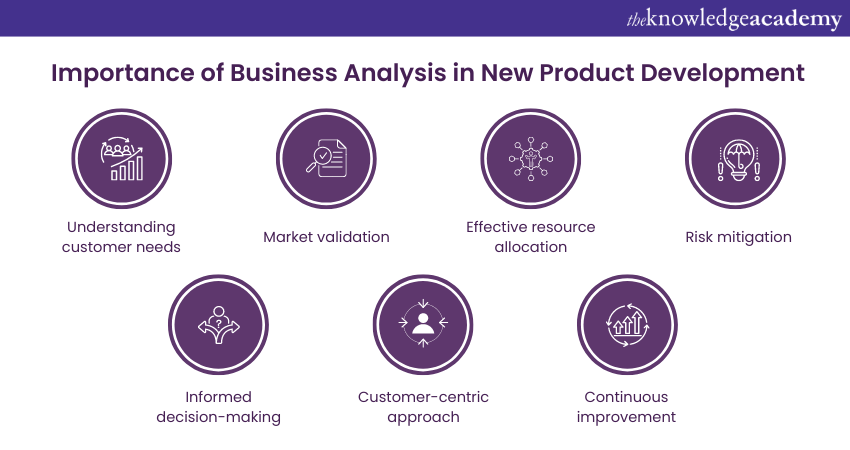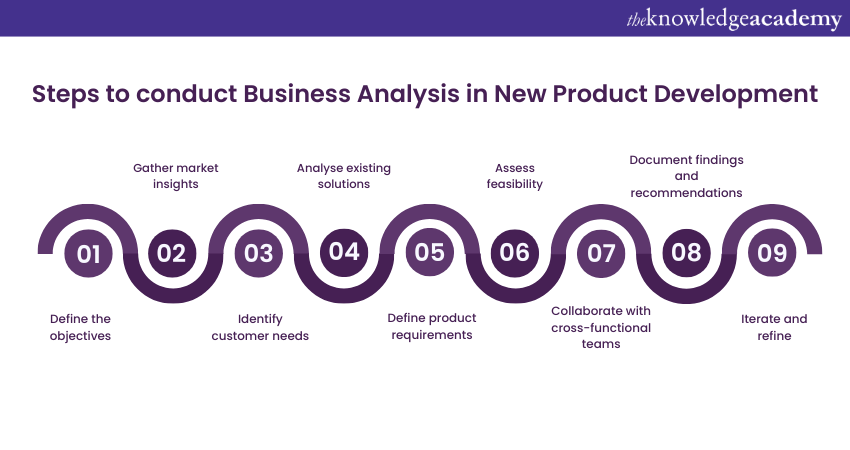We may not have the course you’re looking for. If you enquire or give us a call on +91 8037244591 and speak to our training experts, we may still be able to help with your training requirements.
Training Outcomes Within Your Budget!
We ensure quality, budget-alignment, and timely delivery by our expert instructors.

In this era of hyper-competition, the only way for companies to remain competitive is by constantly innovating and developing new products. However, the success of new product development hinges on understanding market needs and making informed decisions. This is where Business Analysis in New Product Development comes into the picture. Business Analysis involves a thorough examination of market trends, competitor strategies, and customer feedback to provide actionable insights that guide the strategic decision-making process in creating successful and market-responsive products..It involves a systematic approach to understanding customer requirements.
Employing effective Business Analysis Techniques allows organisations to enhance the chances of developing successful products that meet customer needs. If you wish to maximise profitability and gain a competitive edge, this blog might be what you need. Are you still wondering what is business impact analysis? Well you are at the right place! Keep reading this blog on Business Analysis in New Product Development to learn how it involves a complete evaluation of market analysis and customer requirements.
Table of Contents
1) What is Business Analysis in New Product Development
2) Importance of Business Analysis in New Product Development
3) Key components of Business Analysis in New Product Development
4) Steps to conduct Business Analysis in New Product Development
5) Conclusion
What is Business Analysis in New Product Development
Business Analysis plays a crucial role in the success of new product development initiatives. It systematically evaluates market conditions, customer preferences, and organisational capabilities to guide the development of new products that meet market needs and drive business growth.
Business Analysis helps organisations comprehensively understand the market landscape in the context of new product development. It involves conducting market research to identify customer trends, preferences, and unmet needs. By analysing this information, organisations can understand valuable insights that inform the product development process.
Furthermore, Business Analysis enables organisations to assess the feasibility and viability of new product ideas. It involves evaluating technical requirements, resource availability, and market potential to determine whether a product concept is worth pursuing. This analysis helps organisations make informed decisions about resource allocation and investment, reducing the risk of developing products that may not generate sufficient returns.
Moreover, Business Analysis helps organisations stay competitive in the market. By conducting competitive analysis, organisations can identify key competitors, evaluate their product offerings, and identify opportunities for differentiation. This understanding allows organisations to position their new products effectively and develop unique value propositions that resonate with customers.
Importance of Business Analysis in New Product Development

Business Analysis is pivotal in successfully developing new products. It provides organisations valuable insights, facilitates informed decision-making, and ensures that the developed product meets customer needs and market demands. Let's understand the importance of Business Analysis in the context of new product development:
a) Understanding customer needs: Business Analysis helps organisations gain a detailed understanding of customer needs and preferences. Businesses can identify the target market's unmet needs, pain points, and desires by conducting thorough market research, gathering user feedback, and analysing data. This understanding forms the foundation for developing products that truly resonate with customers.
b) Market validation: Through Business Analysis, organisations can validate the market potential and demand for new product ideas. Businesses can make informed decisions about the viability and profitability of their product concepts by assessing the competitive landscape, analysing market trends, and conducting feasibility studies. This reduces the risk of investing resources in products with limited market acceptance.
c) Effective resource allocation: Business Analysis helps optimise resource allocation during the new product development process. Organisations can prioritise their investments and allocate resources by identifying the most critical customer requirements and market opportunities. This ensures that resources are utilised efficiently, focusing on areas that drive the greatest value and align with the overall business strategy.
d) Risk mitigation: Effective Business Analysis helps mitigate risks associated with new product development. Organisations can proactively identify and address potential obstacles by assessing the feasibility, technical requirements, and potential challenges. This enables them to develop contingency plans, allocate resources appropriately, and minimise the impact of unforeseen circumstances.
e) Informed decision-making: Business Analysis gives decision-makers the necessary insights and data to make informed decisions throughout the product development lifecycle. By analysing the information obtained from market research, customer feedback, and competitive intelligence, organisations can evaluate various options, weigh potential outcomes, and select the most favourable course of action. This minimises the likelihood of costly mistakes and increases the chances of developing successful products.
f) Customer-centric approach: Business Analysis ensures a customer-centric approach to new product development. Organisations can design products that truly address customer requirements by understanding customer needs, preferences, and pain points. This leads to higher customer satisfaction, increased adoption rates, and improved market competitiveness.
g) Continuous improvement: Business Analysis supports a culture of continuous improvement within organisations. Businesses can identify opportunities for product enhancements, feature additions, and future iterations by gathering feedback, monitoring market trends, and analysing product performance. This allows them to stay ahead of customer expectations, adapt to changing market dynamics, and maintain a competitive edge.
Interested in Business analysis? Try our BCS Certificate in Requirements Engineering course!
Key components of Business Analysis in New Product Development
Business Analysis is crucial for developing new products and involves several key components essential for the process's success. These components encompass various activities and techniques that enable organisations to gain insights, make informed decisions, and develop products that meet customer needs. Let's explore the key components of Business Process Analysis that help in developing new products: By incorporating Business Process Analysis into each stage of the product development lifecycle, organisations can ensure that new products not only meet market needs but also seamlessly integrate into existing business operations, maximising their impact and value.
Market research
It is a crucial component of Business Analysis. Market research involves information gathering regarding the target market, including customer preferences, market trends, competitors, and industry dynamics. Through techniques such as surveys, interviews, and data analysis, organisations can comprehensively understand the market landscape and identify opportunities for new product development.
Customer analysis
Understanding customer needs and preferences is vital in new product development. Customer analysis involves segmenting the target market, identifying customer personas, and conducting customer surveys or interviews to gather insights. By analysing customer behaviour, pain points, and desires, organisations can tailor their product offerings to meet specific customer requirements.
Feasibility assessment
Assessing the feasibility of new product ideas is crucial before investing resources in their development. This component evaluates technical feasibility, market potential, resource availability, and financial viability. By conducting a thorough feasibility analysis, organisations can identify potential challenges, estimate costs, and determine the viability of the new product.
Learn about business finance with BCS Foundation Certificate in Organisational Behaviour!
Requirements gathering
Defining clear product requirements is essential for guiding the product development process. This component involves eliciting and documenting user requirements, business needs, and technical specifications. By engaging stakeholders and utilising techniques such as interviews, workshops, and prototyping, organisations can ensure that the product is designed to meet customer expectations.
Competitive analysis
Understanding the competitive landscape is vital for positioning the new product effectively. The competitive analysis involves assessing competitors' products, strengths, weaknesses, and market share. Organisations can differentiate their product and develop a competitive advantage by identifying gaps or unique selling points.
Risk analysis
Assessing and managing risks is crucial in new product development. This component involves identifying potential risks and uncertainties that may impact the product's success. Organisations can minimise potential obstacles and improve the chances of successful product development by conducting risk analysis and developing risk mitigation strategies.
Financial analysis
Financial analysis helps organisations evaluate new product development's economic viability and profitability. It involves estimating costs, pricing strategies, revenue projections, and return on investment. Organisations can make informed decisions about resource allocation, pricing, and market positioning by conducting financial analysis.
Collaboration and communication
They are essential to Business Analysis in developing new products. This facilitates cross-functional collaboration between product managers, designers, engineers, marketing teams, and other stakeholders. Organisations can ensure everyone is aligned and working towards the same goals by fostering effective communication channels and promoting collaboration.
Gain higher proficiency with BCS Certificate in Business Analysis Practice course!
Steps to conduct Business Analysis in New Product Development

Conducting effective Business Analysis in developing new products involves a systematic approach to gathering, analysing, and leveraging information to drive informed decision-making. Here are the steps to conduct an effective Business Analysis in the context of new product development:
a) Define the objectives: Clearly define the objectives of the Business Analysis process. Identify the specific goals and outcomes you want to achieve through the analysis, such as understanding customer needs, identifying market opportunities, or assessing the feasibility of the product.
b) Gather market insights: Conduct thorough market research to gather insights about the target market, including customer preferences, emerging trends, and competitive landscape. Utilise various research methods such as focus groups, surveys, interviews, and data analysis to comprehensively understand market dynamics.
c) Identify customer needs: Engage with customers to identify their needs, pain points, and desired features in the new product. Employ techniques like interviews, user surveys, and observations to gather valuable feedback. Analyse the data collected to uncover common patterns and prioritise the most critical customer requirements.
d) Analyse existing solutions: Evaluate existing products or solutions in the market that address similar customer needs. Identify their strengths, weaknesses, and unique selling points. This analysis will help you understand the competitive landscape and determine opportunities to differentiate your new product.
e) Define product requirements: Based on the market insights and customer needs, define the specific requirements and specifications for the new product. Collaborate with stakeholders, including product managers, designers, and engineers, to comprehensively understand the product scope and features.
f) Assess feasibility: Conduct a feasibility analysis to evaluate the feasibility of the new product by assessing factors such as resource requirements, production capabilities, cost analysis, and potential risks. You can easily make informed decisions regarding the viability and profitability of the product.
g) Collaborate with cross-functional teams: Foster collaboration and communication among cross-functional teams involved in the new product development process. Facilitate regular meetings and workshops to align each team member's understanding, expectations, and responsibilities.
h) Document findings and recommendations: Document the findings, insights, and recommendations derived from the Business Analysis process. Create clear and concise reports communicating the identified market opportunities, customer requirements, and potential strategies for successfully developing and launching the new product.
i) Iterate and refine: As the product development progresses, continue to gather feedback, analyse data, and refine the Business Analysis. Adapt to changes in the market, customer preferences, and internal dynamics of the organisation. Maintain flexibility and continuously iterate on the analysis to ensure the new product remains aligned with the market's evolving needs.
Try our Business Analysis Training courses and bridge the gap between IT and Business!
Conclusion
Business Analysis in New Product Development is vital for organisations. By conducting thorough market research, understanding customer needs, assessing feasibility, analysing competition, managing risks, and collaborating effectively, organisations can develop innovative products that meet market demands and drive business success.
Interested in business analysis? Try our BCS Foundation Certificate in Business Analysis!
Frequently Asked Questions
Upcoming Business Analysis Resources Batches & Dates
Date
 BCS Certificate in Business Analysis Practice
BCS Certificate in Business Analysis Practice
Mon 13th May 2024
Tue 28th May 2024
Mon 10th Jun 2024
Mon 24th Jun 2024
Mon 8th Jul 2024
Sat 20th Jul 2024
Mon 22nd Jul 2024
Mon 5th Aug 2024
Mon 16th Sep 2024
Mon 30th Sep 2024
Mon 28th Oct 2024
Sat 2nd Nov 2024
Mon 25th Nov 2024
Mon 9th Dec 2024









 Top Rated Course
Top Rated Course



 If you wish to make any changes to your course, please
If you wish to make any changes to your course, please


